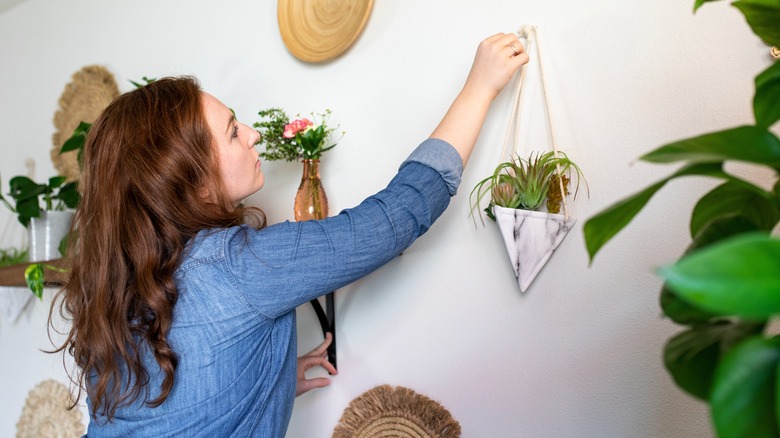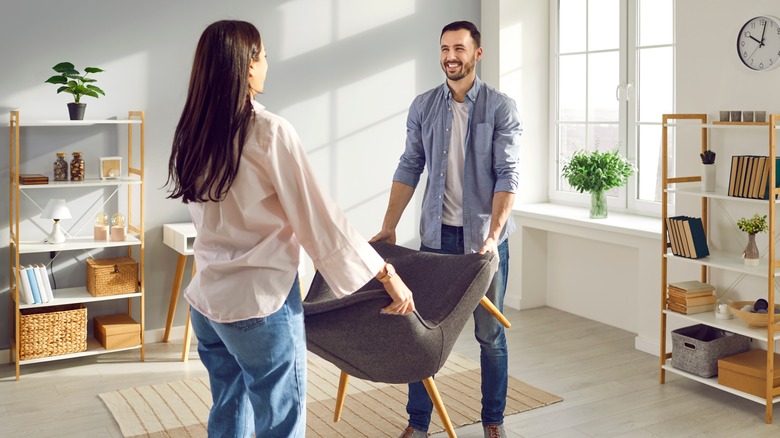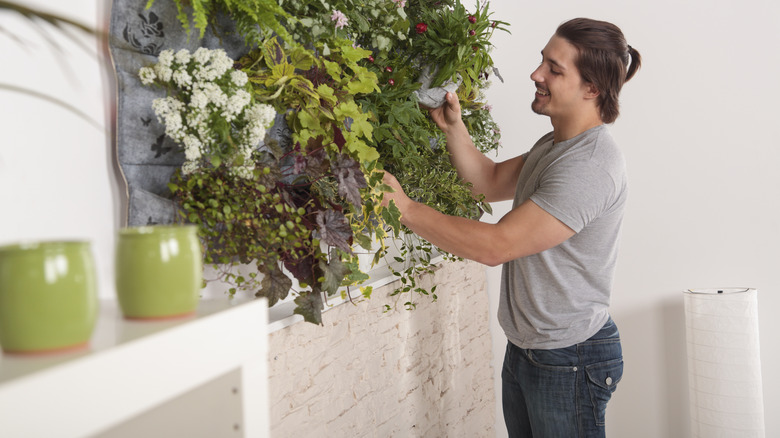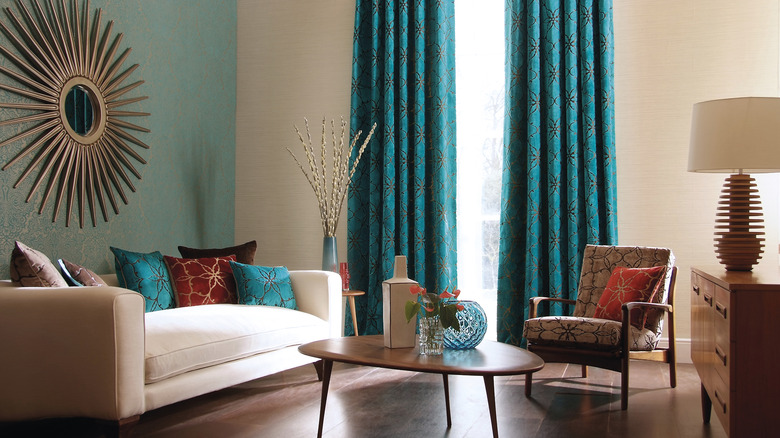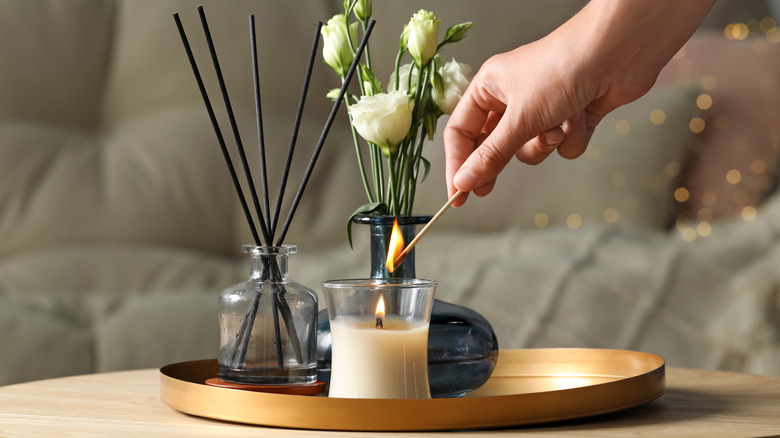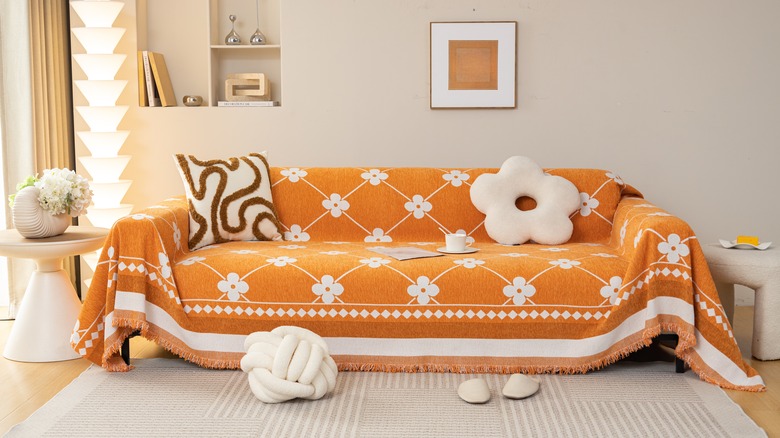Stunning Ways To Refresh Your Living Room Without A Drop Of Paint
We may receive a commission on purchases made from links.
Your living room should be one of the most comfortable places in your world; an area where everyone in your household wants to congregate, hang out, and relax. So, if you're tired of the way this space looks and feels, you deserve an upgrade — no paint required. Painting is a big commitment that can be messy, expensive, and not even an option for most renters. Luckily, there are easier, cheaper, and potentially even more impactful ways to refresh your living room.
From changing up the furniture layout to adding an indoor plant wall to swapping out light bulbs, there's a wide range of no-paint ways to upgrade your living room. Pick and choose the ones that work for your tastes and budget. Consider this a fun chance to experiment with dramatic new curtains or other temporary changes, since you know you can also switch back if something doesn't look right. Prepare to spend a lot more time hanging out in your new favorite room of the house.
Rework the layout
Did you ever experience the thrill of rearranging your bedroom furniture as a kid? Something as simple as moving the bed from one side of the room to another could make the whole space feel new. Reworking the floor plan can have the same made-new effect in your living room, and it costs zero dollars and zero cents.
There are a lot of great ways to approach a new layout, but there's one mistake you absolutely don't want to make: pushing furniture around without a plan. (Cut to you, an hour later, sweaty and miserable, having pushed the couch across the room only to discover it doesn't fit in the spot you'd envisioned.) The old-school strategy is to measure all your walls, windows, doors, and furniture. Then, create a miniature paper layout of the room to scale, including cut-out pieces representing your furniture. You can now simply move the pieces around until you discover a furniture layout that works. Or, tech-savvy folks may want to use digital tools to prep for a rearrangement. Apps such as Room Planner and sites like floorplanner.com can be used to render both 2D and 3D floor plans for a living room refresh.
Clear out clutter
This one's not for the minimalists, but if yours is a household full of clutter, every horizontal surface in your living room is probably covered with stuff. A crowded space can feel so much bigger once all those extraneous things are cleared out. And since living in a cluttered space is scientifically linked to anxiety, stress, and poor productivity, this is one way to refresh your space that could also potentially improve your mental health, too. Then, not that you want to add clutter back in, but you will free up space for any new items you want to incorporate.
The daunting thing about decluttering is figuring out where to start.You can certainly try moving through the room looking for things you no longer use (such as old VCRs and other gadgets, outdated catalogs, empty baskets, etc.), or use a more systematic approach. The Marie Kondo method has worked for a lot of people, but it can be time-consuming and emotionally fraught. Try finding a decluttering expert on social media whose system you really like, and follow their process. As one example, Dana K. White of A Slob Comes Clean has made a range of YouTube videos that walk viewers through the steps of her tried-and-true decluttering method. She recommends first doing a sweep through the space looking for trash, then a second sweep looking for things that belong in a different room, then a sweep looking for things that need to be donated, and so on. Focusing on a specific task at each stage of the process might make decluttering feel easier than just jumping in with no plan.
Create an accent wall
Creating an accent wall can feel a little bit like trying out a totally new hairstyle: There's always a risk you won't like the results. That's one of the perks of using paint-free methods to do it. Covering one wall with removable wallpaper, creating geometric shapes using decorative tape, or installing a wall garden can all be temporary additions to your decor. You could even change a paint-free accent wall every so often, as if your home is a museum with rotating exhibits.
Temporary wallpaper and decorative tape are both fairly straightforward ways to transform a wall, but what about creating a living wall garden? Consider a few approaches to find the right one for you and your home. You could install wooden slats and simple shelves to hold potted plants (as demonstrated by @cedar_hill_builder on TikTok), but it requires some DIY skills and isn't renter-friendly. Or, if you love indoor climbing plants, attach chain trellises to the ceiling or wall. Set potted climbing plants like ivy or pothos on the floor or on low stands under the hanging trellises. Watch them climb and cover your walls over time. You could also install hanging plant pockets ($18), or check out lightweight renter-safe wall planters, like these 3D-printed ones ($25) that attach to walls using adhesive strips. A word of caution to pet owners: Make sure all plants are safe for your animals before hanging them. Some, like pothos, are toxic to cats and dogs.
Refresh window coverings
Changing window coverings can do more than just refresh the look of the living room. It can bring in more light, improve temperature regulation, and create more privacy. And we've come a long way from the days when your window covering choices were either lace or beige. From major retailers like Target and Home Depot, to artisans on Etsy, there are hundreds of affordable options out there for stylish curtains in any style. And, the range of smart blinds and window coverings available today allow you to open and close blinds on a set schedule. That's definitely a cool feature for a lot of reasons. (The catch: Compared to curtains, smart blinds tend to be pricier and require professional installation.)
Aesthetics aren't everything, though. Function and usability are super important factors when choosing window coverings. Do you want light to be able to filter into the room even when the curtains are closed? Consider linen or cotton curtains with an open weave. Pairing them with sheer curtains gives you more control over how much light flows in. Lined blackout curtains might be preferable if you live in a city and want to block out bright lights at night. Fabric care is a consideration, too. When your curtains get dusty, will you be able to machine wash them? Certain fabrics, like silk, look great on your windows, but are harder to wash.
Change lighting, scents, and sounds
Lighting, scents, and sounds are some of the design intangibles that you don't necessarily notice in your space... until they change. We all become accustomed to the sensory experience and feeling of walking through our own homes. Adding a scent diffuser and keeping music playing quietly through a living room speaker are just some ideas for refreshing the energy of your living room. Other ideas include setting up a tabletop water feature to imitate the sound of a babbling brook. Or, swap out cool-toned lightbulbs for bulbs that give off warmer, yellow light. Look for bulbs in the temperature range of 2400-3000K. (If the room feels too dim with warmer bulbs, add a few new lamps to compensate!)
These may sound like small tweaks, but engaging the five senses can have a big effect on how you and your guests feel when they walk through the room. Sensory experiences can help with emotional regulation, says clinical psychologist Liz White, but not everyone is soothed by the same things. It's important to choose sights, sounds, and smells that feel comforting to you specifically.
Cover upholstered furniture
Disguising a beige couch under a brightly patterned slipcover can trick your eye, and your visitors, that you changed the coloring of the room. Covering upholstered furniture is often a practical decision made by pet owners and parents of young kids, because it helps shield the fabric from stains and fur, and makes cleaning easier. But, on top of that, it can also be a way to add new colors and textures to your living room.
If you read "slipcover" and picture something boring, old-fashioned, or cheap looking, you haven't explored the range of options available today. Companies such as Ownkoti make stylish and affordable covers constructed with stretchy material, so they're easy to put on and fit snugly over furniture of different shapes. Want an even easier way to disguise your existing living room furniture? Drape a flat sheet over a sofa or upholstered chair. Tuck the fabric into the crevices around the cushions. Or, just find a blanket you love and drape it over the couch loosely. While you're at it, why not add new covers to your throw pillows? Find covers in ton of colors and shapes online, or DIY your own if you have basic sewing skills!
